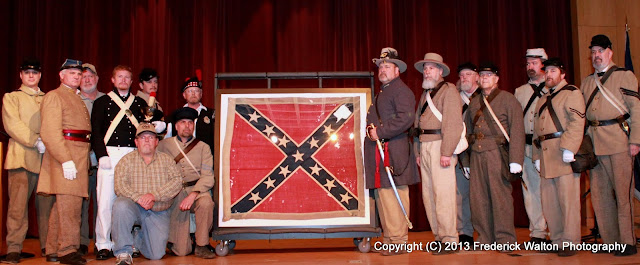Published: April 7, 2013 in the Raleigh News and Observer (section B, page 1)
"Bloody 6th" Battle Flag at Home
N. C. Regiment lost it in Virginia; Museum brings it home to Raleigh
By Renee Elder — relder@newsobserver.com
RALEIGH — A Confederate battle flag lost in the final months of the Civil War was handed over again Saturday – this time back into the collection of the N.C. Museum of History following a $6,500 restoration.
The flag was carried by the 6th Regiment of North Carolina [State Troops] at the Battle of Sailor’s Creek in Virginia when it was captured by a Union soldier on April 6, 1865. Forty years later, the federal government returned the flag to North Carolina, but it remained hidden in storage because the torn and dirty fabric was not suitable for display, said Jackson Marshall, assistant director of programming at the history museum.
“It’s been 100 years since the public has seen this flag,” Marshall said. “Now it’s cleaned and conserved in a way that will protect it for another 40 or 50 years.”
The museum is short on funds for restoring historic artifacts and must depend on private groups such as the Cedar Fork Rifles Preservation Society[1], which raised money to restore the 6th [North Carolina State Troops] Regiment flag, he added. The museum has about 125 battle flags but only about 30 have been cleaned and preserved so they can be made available for display.
More than 100 people from across the state came to the dedication Saturday to see the flag and share stories about the N.C. 6th Regiment, which formed in Charlotte [Company Shops, N. C., present day Burlington, N. C. ] in May 1861 and fought its first major battle two months later in Manassas, Va., also known as the First Battle of Bull Run.
“It was the only North Carolina battalion [to fight] at that first great battle of the war,” said Rick Walton, a Civil War historian and member the Cedar Fork Rifles Preservation Society. [2]
Known as “the bloody 6th,” the regiment fought constantly during the war and at many famous battle sites in throughout Virginia, Pennsylvania and North Carolina: Yorktown, Sharpsburg, Fredericksburg, Chancellorsville, Gettysburg, New Bern, Plymouth, Petersburg and others. Starting out with 1,000 members, the ranks were diminished by injuries and deaths after years of fighting. Replacements were brought in whenever possible, Marshall said.
Sailor’s Creek, about 60 miles southwest of Richmond, was the last battle fought by the 6th Regiment, which carried a practically new flag that had been issued to replace others lost or captured in battle.
“We don’t know who the 6th’s flag-bearer was that day; in fact we know more about who captured it,” Walton said.
Joseph Kimball, of Littleton, N.H., got credit for taking the 6th Regiment battle flag; he was awarded one of the 57 medals handed out by the Union Army for military service on that day.
The Confederate battle flag has 13 five-pointed stars set on an “X” pattern, known as St. Andrew’s Cross but also sometimes called a Southern Cross. It is distinct from the Stars and Bars design of the Confederate States of America flag.
 |
| Sailors Creek Battle Flag before Conservation |
This 6th Regiment’s battle flag is missing a star, which was cut rather than ripped from the fabric, indicating it was likely taken as a souvenir from the battlefield or after the war, Marshall said. Conservators who prepared the flag for exhibit cleaned and protected the delicate fabric but did not change the flag’s overall appearance.
The Confederate Army lost more than 7,700 men at Sailor’s Creek. Just 72 hours later, General Robert E. Lee surrendered at Appomattox Court House.
More than just a symbol of a long-ago military conflict, the flag represents family history for many of those who came to see the flag rejoin the museum’s collection, Walton added.
“What this represents to us is heritage,” he said. “It’s a visual reminder of our ancestors.”
Marshall said North Carolina troops suffered massive losses in the Civil War -- as many as 35,000 men were killed and thousands more severely wounded.
“In Gettysburg, almost 25 percent of the total losses were North Carolinians killed or wounded,” Marshall said.
He said North Carolina’s Civil War heritage remains strong largely because of the losses so many families endured.
“I’m astounded at how many people give money to these efforts because they know they have a family connection,” he said. “People still remember the suffering and loss and want to keep family memories alive.”
NOTES
1. The Cedar Fork Rifles Preservation Society is the formal name of the living history organization that incorporates the Sixth North Carolina State Troops reenacting group.
2 Two other North Carolina units were present at Manassas but not actually engaged. The 11th Volunteers/21st NCT were stationed one mile northwest of Mitchell’s Ford on Bull Run, but were not engaged in the battle. The 5th North Carolina State Troops were stationed at Blackburn’s Ford on Bull Run. The regiment was not engaged but was under artillery fire.





No comments:
Post a Comment